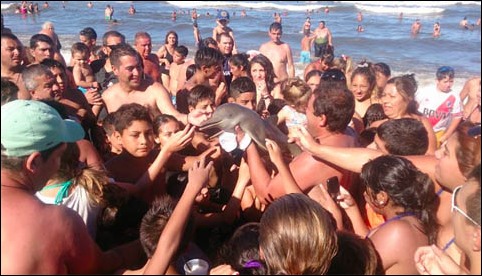A Mob by Any Other Name

The world is horrified by the recent upsetting story of an infant Franciscana dolphin who was taken out of the water by beachgoers in Argentina and passed around as a prop for selfies, and who then died. The unfortunate infant could cialis sans ordonnance not maintain body temperature, and she likely became dehydrated when out of the water.
But her death is so much more than just a case of a manhandled animal. Her story is a microcosm of what our species does to other animals every day, treating them as objects for our benefit, with value only as long as they provide entertainment.
It is difficult not to see the connection between how this young dolphin was used and what happens at the institutionalized versions known as zoos, aquariums and circuses. The only difference is that one has to pay for a ticket to gawk at, touch or ride on the animals at one of these facilities. But the psychology is the same.
Treating them as objects for our benefit, with value only as long as they provide entertainment.
Zoos and aquariums offer visitors the opportunity to see animals who are also “taken out of the water” and placed in artificial circumstances that often lead to abuse and death. There is little difference between what happened to this infant and what has been happening to dolphins and whales for decades in theme parks. Out of their natural, physical and social environment, these animals not only cannot thrive but often cannot even survive. This is why high mortality rates, low survival rates, abnormal behaviors, and stress-related diseases are rampant in the dolphin and whale captivity industry.
The figures speak for themselves: In the span of just a few months, four marine mammals have perished prematurely at SeaWorld San Antonio: an 18-year old orca, a 12-year old Pacific white-sided dolphin, a 2-year-old beluga whale, and a newborn beluga.
And since its opening in 2005, there have been five premature deaths of belugas at the Georgia Aquarium: a 17-year-old male, a 25-year-old female, and a 21-year-old female and her two calves, each less than a month old. In the case of the mother and her calves, the youngsters failed to thrive, and photos of trainers and other aquarium staff in the water handling the newborns are eerily similar to what happened on the beach. Though the aquarium staff may have been trying to save the infants, their attempts are poignant failures of understanding of who these animals really are and what they need to thrive.
While the world expresses shock and dismay over the death of the infant on the beach in Argentina, we should remind ourselves that this incident sits within a wider context of the exploitation of nonhuman animals for entertainment, and an industry that not only condones but promotes the kind of behavior that leads to worldwide animal abuse and exploitation.
Buying a ticket to be part of the audience at a dolphin or whale show is basically no different from being part of the mob on that Argentinian beach.
2 Replies to “A Mob by Any Other Name”
Comments are closed.

[…] article originally appeared on Kimmela. It has been reprinted here with […]
This is so very sad why wasn’t this beach being Patrol knowing so many tourist were at the beach? This poor baby suffers because of stupid humans who don’t leave the wild in the wild!! It really pisses me off.